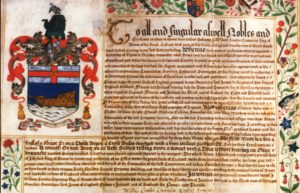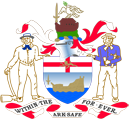A Shipwrights' Hall
By David I.Moor, Past Prime Warden and Hon Historian
"It is not unknown by all that an assembly of the brethren and sistern of the Fraternity of St. Simon and St. Jude had been held in London by the craft of Shipwrights time out of mind."
Thus begins one of the Company's oldest documents, still in existence, written almost 500 years ago. Unfortunately it was not recorded where the Fraternity assembled. It is reasonable to suppose that it met in a church, probably one of those near the river in Upper or Lower Thames Street, but most of them were severely damaged or destroyed in the Great Fire, and it is unlikely that any clues or evidence will now be found.
In the following century shipwrights practising their trade within the City were compelled to abandon their yards because of the noise they made, and the fire risk from their stores of timber and tar. Some of them moved down river to Ratcliffe, others across to Southwark, others up river. Meetings were probably held in Guildhall, as they were known to have been later.
The 'Foreign' Shipwrights and Shipwrights Hall.
Down river on the Kent and Surrey shores were the Royal Dockyards and builders of warships, who later spread into Redriff or Rotherhithe. These Kent and Surrey builders were not Freemen of the City and in 1605 joined with others around the country to obtain a charter as 'the Shipwrights of England', for 'a convenient house or hall for their use to be by them provided within the City of London or suburbs of the same or within five miles of the said City'.
Nothing is known of this hall, referred to from time to time as Shipwrights’ Hall, though it is said to have been in Redriff: certainly these 'foreign' shipwrights, when they obtained a new charter in 1612, called themselves the 'Shipwrights of Redriff in the County of Surrey'. For the next seventy five years they endeavoured to impose their will on the shipwrights of London and elsewhere, and in a final attempt at domination, surrendered their charter to James II, whose successors, William and Mary, declined to renew it.
The Company ceased its main activities, but around the turn of the century some of its members appear to have met for a brief period in a house in Butchers Row, Ratcliffe, labelled Shipwrights’ Hall on Gascoyne's detailed map of 1703.

In 1705 they petitioned once more for a new charter, but were again unsuccessful and the Company finally disappeared soon afterwards. In 1794 most of Ratcliffe was destroyed in a great fire which started in the Cock Hill Yard of a Mr Cloves (probably Daniel Cloves, Citizen and Shipwright). In one of the few houses to survive, Bere House, was found the 1605 grant of arms to the 'foreign' shipwrights, which eventually came into the possession of the Worshipful Company and is today one of our great treasures.
The "Free" Shipwrights
Unlike the "foreign" shipwrights, the Worshipful Company appears never to have had a home of its own. Throughout the seventeenth and eighteenth centuries meetings were held at Guildhall, often in the Gallery, but usually in the Irish Chamber. In the decade before the granting of the Livery in 1782, the Court met at various taverns (notably the St. Paul's Head in Cateaton Street); once at Jamaica House, Rotherhithe; and once at the Three Sugar Loafs, Putney, the locale clearly being chosen for the following dinner rather than business convenience!
After the granting of the Livery, "as the Company had no proper office to transact their business in but in the office of the Town Clerk of the City of London, and that only on sufferance, which is found disagreeable to the Town Clerk, the present Wardens have agreed with the Keeper of the Guildhall to have the free use of the Irish Chamber at all times to transact the Company's business in, for the annual sum of £2.12.6.", noting with satisfaction that "the Company now have free access to their chest" - the great iron muniment chest which had been kept in the Guildhall and is today on loan to the Museum of London. For some unknown reason the arrangements did not last, and for the next thirty years most meetings were held at the Guildhall Coffee House in King Street. There followed half a century of meetings in Guildhall, but after the enlargement of the Company in 1876, there was a reversion to taverns and hotels (for thirty years principally the Albion in Aldersgate Street, quite near Ironmongers' Hall) and the first of a long line of visits to other Livery Halls.
Before and during the Great War, the offices of successive Masters were used, until the appointment as Clerk of F. C. Lingard, who was already Clerk to the Bakers' and Barbers' Companies. He arranged for the Company to use first Bakers' Hall, then Fishmongers' Hall, until a permanent agreement was made to use Barbers' Hall, the Company's home for twenty years until the building was bombed. Thereafter the Vintners' Company were the Company's hosts (except during 1945 when the Mansion House itself was used while Sir Frank Alexander, Second Master, was Lord Mayor) until in 1956 it was finally resolved not to proceed with the pre-war proposal to build a Shipwrights' Hall in Bucklersbury, and an agreement was made to use accommodation in the Baltic Exchange. After ten years, the practice of holding meetings, followed by dinners, in other Livery Halls was revived. Since 1972 a court meeting and lunch has been held every July at Trinity House. In 1979 the Company left the Baltic Exchange to become tenants at Ironmongers' Hall, its present splendid home.
Proposals for a Hall
In 1919 Sir Eustace Tennyson d'Eyncourt suggested that the Company should acquire a surplus warship for conversion to a livery hall, but the idea was considered impractical. At the same time the site of Cliffords Inn, Fleet Street, came on the market and the Court considered a proposal to purchase it and use the old hall as a court room, and to build alongside it a library and museum, with a livery hall above, and an office block, with the thought that the whole, in conjunction with the Institution of Naval Architects, might in time become a central meeting place for all interested in shipbuilding and shipping. After an enthusiastic initial reception, the Court rejected the idea as too costly, but the Master, Sir Archibald Denny, gave £1,000, a large sum in those days, to start a housing trust fund, and a housing committee was set up to consider alternative proposals.
The exact sequence of events thereafter is not known, as Court records for the inter-war and early war period were destroyed during the bombing. Plans were drawn up for the conversion of the clipper ship "Cutty Sark" to a livery hall, but counsel advised that the trust fund monies could be used only for a building on land. By 1938 a private company, Shipwrights’ Hall Ltd., all of whose shares were held by the Worshipful Company or its nominees, was set up “to acquire, hold and manage, a Hall in the City of London to be occupied or used by or for the benefit of the Worshipful Company of Shipwrights." This company acquired the freeholds of a number of properties between Cheapside, Bucklersbury and Pancras Lane, bounded by the disused churchyards of St. Pancras and St. Benet Sherehog, plans drawn up for a fine modern hall and office block, and an appeal was launched for more capital.
The existing property on the Bucklersbury site was destroyed by bombing and after the war the whole project came into question when a new road was projected right through the site. Alternative proposals to acquire adjacent land or to join with Trinity House in the erection of their new building fell through but the freehold of the pre-war site was retained until sold in 1959. In retrospect, it is perhaps fortunate that the pre-war designs, shown in a splendid brochure about the Company issued in 1957, were not implemented, since the accommodation was far too small for the much larger and more active Livery of today.
The Shipwrights’ Hall Company was dissolved in 1967, and the balance of its assets transferred to the Worshipful Company to be placed in a housing and general purposes fund which was itself absorbed into the general fund in 1979.
The next serious proposal, in 1967, was to acquire the redundant church of St. Andrew Undershaft in St. Mary Axe, which contains a window showing the Company's Arms in commemoration of the many annual services it had held there. Negotiations with the church authorities were unsuccessful and ceased after five years. They were followed in the early 1970s by a spate of proposals to build a new hall in the redevelopment of Hay's Wharf or of the Customs House and Wool Quays; or to acquire and moor in the Thames Brunel's "Great Britain"; the one hundred year old gunboat "Gannet" (better known as the training ship "Mercury") or the Clyde paddle steamer, "Caledonia".
The late 1900s brought proposals to acquire the Mermaid Theatre; the cableshjp "John W. Mackay"; Lloyd's of London’s board room suite, including the Captains' Room; or the old City of London School for Boys, in the continuing search for the means to achieve one of the dearest traditions of each of the great livery companies of the City - to own and keep its own hall.












